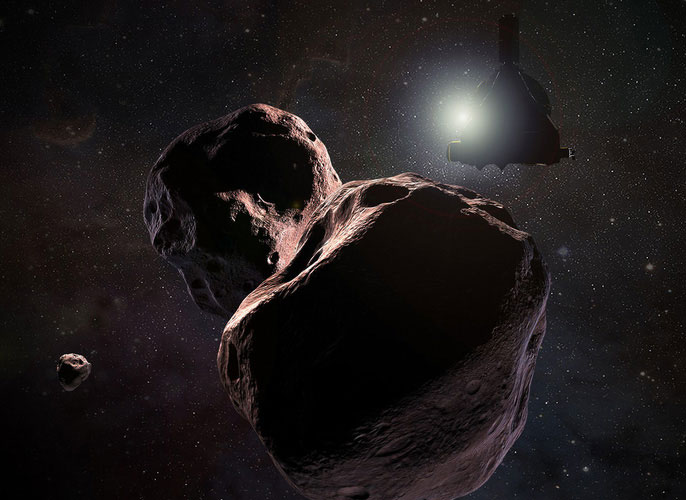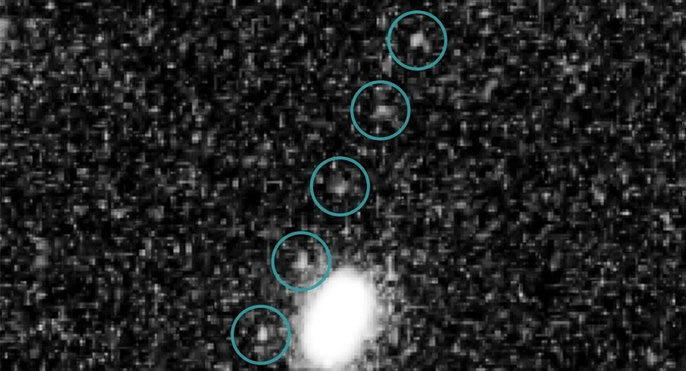Magnetic anomalies' asteroids cannot reach
The asteroid picked up NASA in accordance with the nickname they called it - Ultima Thule, "the land cannot be reached" - the first mystery of the "light curve".
Scientist Alan Stern, one of NASA's key members of New Horizons mission, said that even though it was very close to the Ultima Thule asteroid, they still could not capture the " light curve". of this celestial body.
It is not uncommon to be unable to catch any signal from the light curve of an object illuminated by the sun and only a few days away.

On the first day of 2019, NASA will "dock" the mysterious asteroid Ultima Thule - (graphic image from NASA).
In astronomy, the light curve is the term for a set of predictable and consistent variations of celestial light reflections, which are important data for scientists to learn about celestial bodies. .
"It's the first puzzle of Ultima," said Stern. According to calculations, New Horizons was very close to this celestial body and will touch it on the first day of the new year: January 1, 2019.

The latest series of New Horizons photos about mysterious bodies without light curves - (photo: NASA).
NASA scientist told Gizmodo that he had just expected, but did not expect the next images of Ultima Thule to bring more mysteries.
Scientists come up with two theories that make this asteroid's light curve like an invisible ghost before New Horizons: it is too faint, faint to strange; or there is a dust cloud covering the Ultima Thule, preserving it in the mysterious veil.
which is NASA's " unmanned " scout , previously on duty. In October, New Horizons received an order to redirect to Ultima Thule. It flies at 32,000 km / hour and is estimated to take about 10 weeks to reach the destination.
Almost at the same time with this interesting information, NASA also briefly revealed the mission Lucy aimed at six other asteroids in the "Trojan asteroids" group near Jupiter.

Simulation of NASA's Lucy Plan: The big red circle is Jupiter's orbit, the green line is the path of Lucy, the yellow ellipses are where target asteroids reside - (photo: NASA) .
These 6 asteroids are estimated to be approximately the same age as the sun and can also partially capture the secrets of the early Solar System like Ultima Thule. The mission will begin in 2021.
Ultima Thule is the nickname of the asteroid bearing the code of 2014 MU69 , a mysterious object in the cold place far away from the center of the Solar System. This asteroid is thought to be a billion-year-old "space monument" and holds the secret of the formation of the Solar System.
Ultima Thule originated from Thule - the legendary island in ancient Greek and Roman literature, somewhere in the Arctic Ocean but no one has arrived. The term Ultima Thule was later used extensively in literature to refer to distant, imaginary, impenetrable lands.
- Asteroids speeding more than 23,000 km / h are about to cross the Earth
- Magnetic storms can ruin the 2012 Olympics
- NASA hangs on the asteroid
- China's super-speed train can reach 1,000km / h
- Change candidates for hunting asteroids
- 10 interesting things about asteroids in the solar system
- Speed can reach 500 km / h or higher
- 4 asteroids are threatening the Earth
- Identify asteroids to lead near Earth
- Four asteroids are flying past the Earth
- Asteroids are about to fly through the earth
- Researchers lost 900 marks of asteroids near Earth
 Van Allen's belt and evidence that the Apollo 11 mission to the Moon was myth
Van Allen's belt and evidence that the Apollo 11 mission to the Moon was myth The levels of civilization in the universe (Kardashev scale)
The levels of civilization in the universe (Kardashev scale) Today Mars, the sun and the Earth are aligned
Today Mars, the sun and the Earth are aligned The Amazon owner announced a secret plan to build a space base for thousands of people
The Amazon owner announced a secret plan to build a space base for thousands of people